My Berlin: Shalekhet (Fallen Leaves), Jewish Museum
The Jüdisches Museum (Jewish Museum) in Berlin’s Kreuzberg district is one of the most visited museums in the German capital. Millions from around the world have visited the museum since its opening in late-2001. With the unique architectural vision and building design by Daniel Libeskind, the museum does not set aside the history of the Jewish community within Germany as being separate from the history of the country as a whole. Instead, there is conscious effort by Libeskind and the Museum to have visitors consider how the historical, cultural, art, literature, music, intellectual, scientific, and economic contributions from the Jewish community are tied inextricably with the history of Germany over the span of two millennia. These very issues and questions are now also driving discussions about the present state and evolution of the Turkish and other expatriate communities within Germany.
One sculpture in particular is both poignant and disturbing.
Fallen Leaves
Sitting at the foot of the empty space “Memory Void” (Leerstelle des Gedenkens) is the 2001 sculptural installation called “Schalechet” (Shalekhet) by Israeli artist Menashe Kadishman.
Visitors are encouraged to interact by walking on the exhibit itself: to see the open-mouths in terror, the faces of soundless screams; and to listen to the jarring clanging sounds when thick metal pieces jostle against other pieces.
It’s an eerie atmosphere with the installation all to myself. I also feel what is unmistakably guilt as I tread on the “screaming” faces. Am I walking over representations of living breathing people? I think these feelings are in fact necessary, that I need to have these feelings of loss. Something important has been taken away. It’s as if the sculpture asks: “Germany is presently incomplete – will the country ever heal and be complete again?”
Near the sculpture, the accompanying caption in English reads:
Leerstelle des Gedenkens (Memory Void):Shalechet or Shalekhet (“Fallen Leaves”), by Menashe Kadishman (born 1932 in Tel Aviv): 1997-2001, sheet steel. Gift of Dieter and Si Rosenkranz.
The architect Daniel Libeskind created empty spaces in several parts of the building. These so-called voids extend vertically through the entire museum and represent the absence of Jews from German society. The Memory Void contains a work by the Israeli artist Menashe Kadishman, who calls his installation “Shalekhet,” or “Fallen Leaves.” He has dedicated the over ten-thousand faces covering the floor to all innocent victims of war and violence.
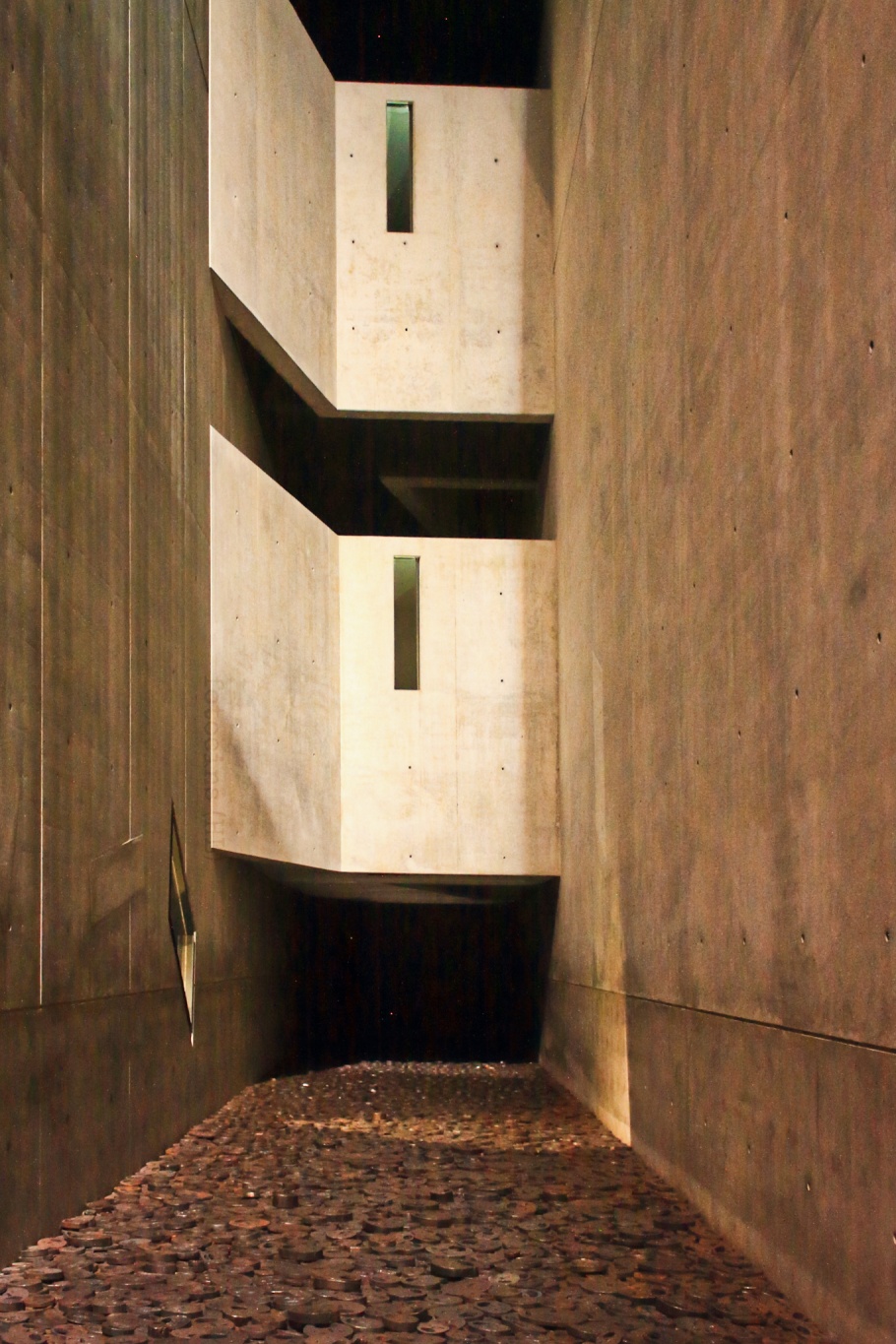
Memory Void, Shalechet – 19 Nov 2012 (450D).
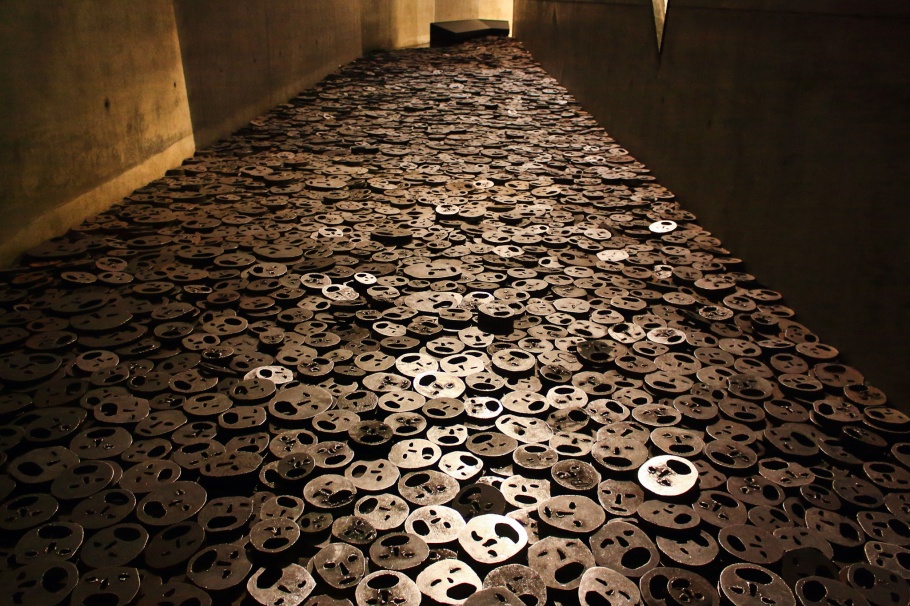
Shalechet (Fallen Leaves) – 19 Nov 2012 (450D).

Terror – 19 Nov 2012 (450D).
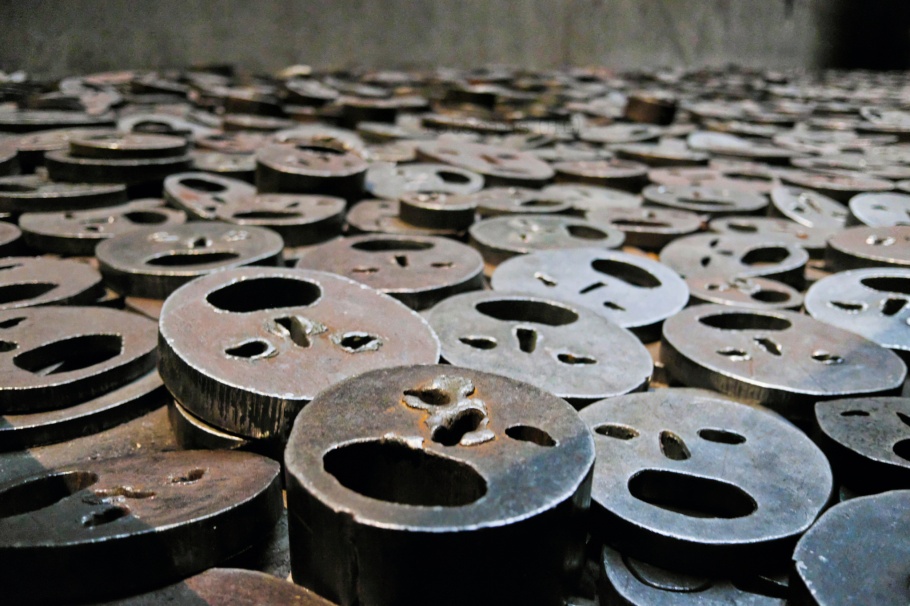
Shalekhet (Fallen Leaves), by Menashe Kadishman – 27 Nov 2021 (X70).
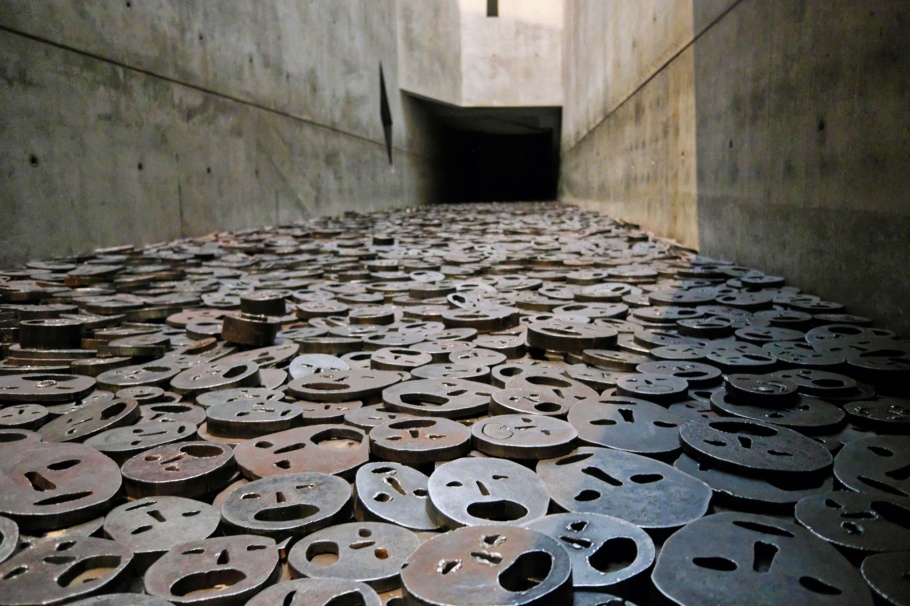
27 Nov 2021 (X70).
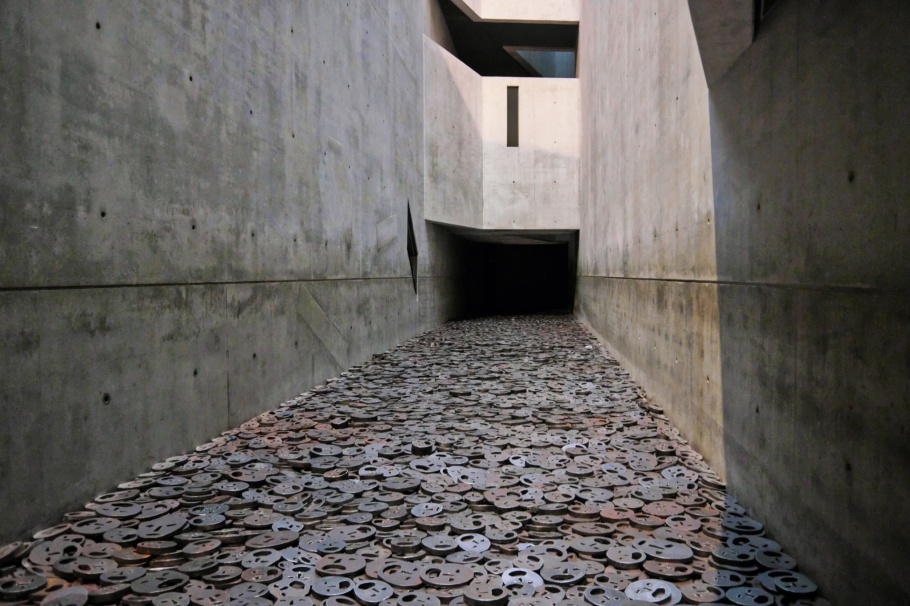
27 Nov 2021 (X70).
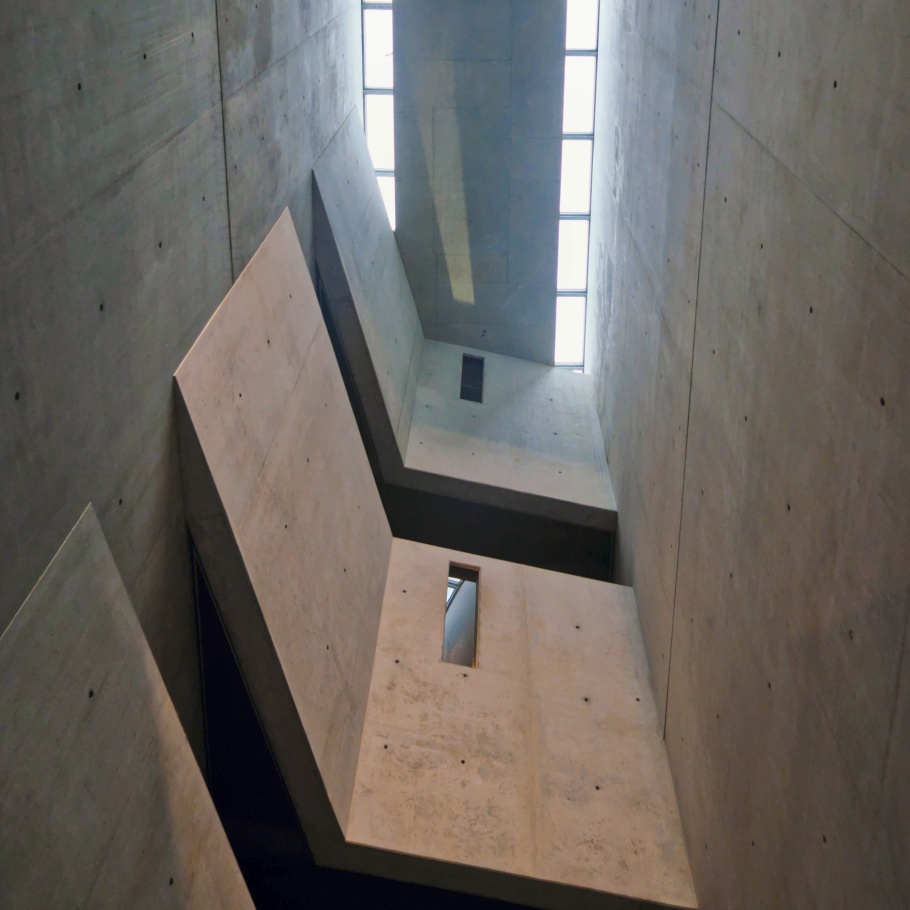
Memory Void – 27 Nov 2021 (X70).
The following two-and-a-half minute video (iPT4) provides sights and sounds which give shape to the “void.”
Getting there
The Jewish Museum Berlin can be reached with public transport:
• with S-Bahn train to station “Anhalter Bahnhof” (S1, S2, S25, S26),
• with U-Bahn train to station “Kochstrasse” (U6) or “Hallesches Tor” (U1, U6), or
• with bus 248 to stop “Jüdisches Museum.”
I made all photos above with a Canon EOS450D/Rebel XSi (450D) on 19 Nov 2012, the video with a 4th-generation iPod Touch (iPT4) on 19 Nov 2012, and additional photos with a Fujifilm X70 fixed-lens prime on 27 Nov 2021 (X70). This important museum is in my list of urban G-E-M-S for Berlin. This post appears on Fotoeins Fotografie at fotoeins DOT com as http://wp.me/p1BIdT-2YP.
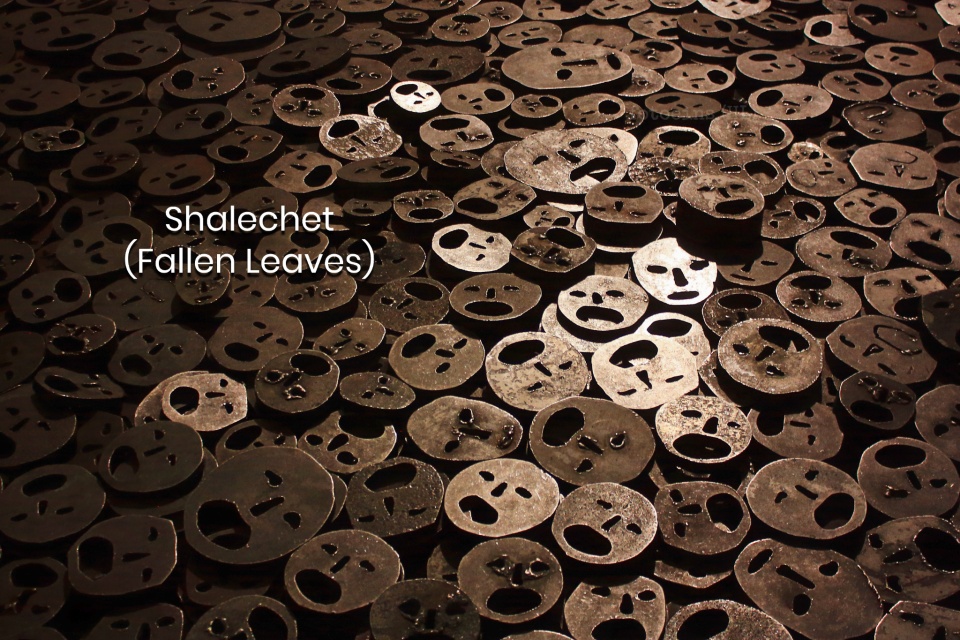
14 Responses to “My Berlin: Shalekhet (Fallen Leaves), Jewish Museum”
I totally understand your feeling of guilt, walking over the metal faces. Memorials and exhibits of horrendous parts of history always play with my emotions. How can they not?
LikeLiked by 1 person
Hi, Tim & Nat. I agree. I also admit I try to balance my emotional and rational responses. The guilt didn’t simply go away, but I asked myself this question: when there’s injustice, what can I do that’s better? I may not always come out smelling like roses, but I have to believe there’s an important beginning with asking that one question. Thanks for reading and for your comment!
LikeLike
[…] I wrote previously about a visit to Berlin’s Jewish Museum, and in particular, about the sculpture installation “Shalechet” (Fallen Leaves). […]
LikeLike
[…] “Shalechet” (Fallen Leaves) : Jewish Museum (HL) […]
LikeLike
[…] The architect Daniel Libeskind created empty spaces in several parts of the building [Jewish Museum]. These so-called voids extend vertically through the entire museum and represent the absence of Jews from German society. The Memory Void contains a work by the Israeli artist Menashe Kadishman, who calls his installation “Shalekhet,” or “Fallen Leaves.” He has dedicated the over ten-thousand faces covering the floor to all innocent victims of war and violence. (Source) […]
LikeLike
I visited this museum 31 December 2017 and it was a profound & thought provoking experience. Unlike many Holocaust museums, this one in particular forces the visitors to think, envision, and truly feel what victims of oppression and societal atrocities experience.
Poldek Pfefferberg (one of Schindler’s children) once wrote, “Remember to never forget”. After visiting this museum one would be hard pressed to not do so.
LikeLiked by 1 person
Sounds really interesting. We haven’t been to Berlin, but when we do we’ll for sure visit. Have you been to Budapest? There’s a fascinating Holocaust memorial there that’s totally different. Take a look here, https://easterneuropetrip.wordpress.com/2016/01/03/budapest-shoes/
Vivienne
LikeLiked by 1 person
Hi, Vivienne. Thanks for the link to your post; I’ll check it out! I’ve only been to Budapest once, and that was over 15 years ago. Yeah, I gotta go back. There’s a lot I’m covering in the German-speaking countries, and naturally, there’s a lot to cover, explore, and discover elsewhere throughout Europe. I once viewed Germany as a “life project” which it still is and always will be. But in fact, I view Europe entirely as a worthwhile “life project.” 😄
LikeLike
[…] but there were many temporary installations to see. One of which sent chills down my spine- Shalechet (fallen leaves) is an exhibition of 10,000 iron open-mouthed faces covering the floor. The iron […]
LikeLiked by 1 person
[…] here for […]
LikeLike
[…] Berlin: Shalechet (Fallen Leaves) at the Jewish Museum. [online] Fotoeins Fotografie. Available at: https://fotoeins.com/2013/04/02/shalechet-jewish-museum-berlin/ [Accessed 14 May […]
LikeLike
When I read the note saying that the artist wants you to walk on it I was surprised. I walked on it and wept. Maybe only art can hit you on such an emotional level. Sadly we don’t seem to learn from it.
LikeLiked by 1 person
Hi, Gary. Thank you for stopping by and for your comment with which I’m in full agreement. Seeing Kadishman’s sculpture isn’t enough; the “experience” of walking on the sculpture in low light surrounded by clanging echoes is an emotional one, as was fully intended by both artist and museum.
LikeLike
[…] Fotographe (2013). My Berlin: Shalekhet (Fallen Leaves), Jewish Museum Available at: https://fotoeins.com/2013/04/02/shalechet-jewish-museum-berlin/ . [Accessed: 16 Oct 2023] […]
LikeLiked by 1 person